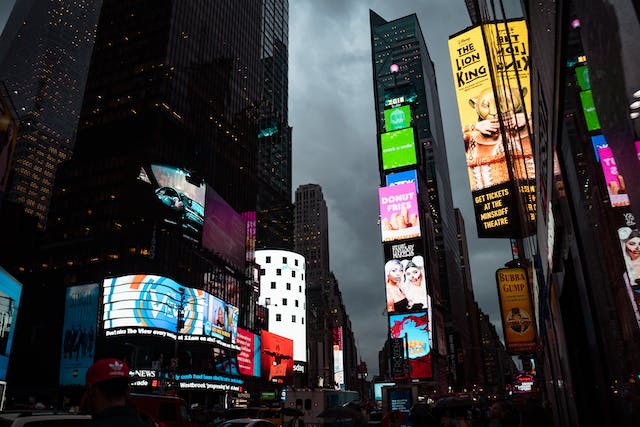Welcome to the new generation of advertising. No longer is it a question of old-style posters or stationary billboards. Digital signage has entered the market and it completely changes the communication approaches in business. This article will discuss the potential of digital signage in the arena of advertisement. Prepare to be astounded as what follows is a journey that began from print to being digital and interactively engaged in social media. Therefore, fasten your seat belts and let’s begin our fascinating expedition to the future in advertisements!
The Evolution of Advertising: From Print to Digital
Advertising has significantly developed since it started with newspapers. In the past, it was only in newspapers and magazines that companies advertised their brands. However, in modern times, particularly with advancement in technology, advertising industry has seen significant transformation.
LED digital signagehas changed the landscape in which brands interact with customers. Not anymore to static billboards and posters; now it is the time for the active display panel, which attracts more than ever before. The advertisement for digital signage has created attractive visual spectacles that take engaging interaction with potential clients to an unprecedented level.
First of all, one should note the flexibility that digital signage has as a crucial advantage. In contrast to conventional static print ads, dynamic digital displays make it possible to replace content with new information more quickly. In other words, advertisers will be able to adjust their messages accordingly depending on prevailing market conditions or promotions.
Moreover, digital signage comes with the ability to interact thus making advertisement more effective than it has never been. Consumers can interact with different types of advertisements such as playing games as well as exploring product information or making orders using touchscreen systems.
Another thrilling part of digital signage involves personalization. Through sophisticated ad tracking technology, advertisers are nowadays able to send personalized ads based on individual taste and location. It improves customers’ experience, and it delivers targeted ads that contain appropriate information to an individual at the right moment.
Digital signage not only enables personalization but also tracks and measures their effects which cannot be done using printers. These are key statistics such as impressions, engagement rate and conversion rates that advertisers could use to measure their viewers. They use this to determine if their ads are working properly and plan more carefully on future campaigns.
Another revolution that has been ushered in by digital signage revolves around integration with social media and mobile devices. Brand’s can utilize social media platforms to amplify their messages that reach beyond physical screens through users sharing content on online platforms like hashtags and @mentions. Additionally, mobile integration enables users to be sent with personalised offers or promos straight on their phones when they hover close by a digital signs board.
Benefits of Digital Signage
Digitization has brought about a much wider range of advantages with regard to commercial advertising than was ever possible previously through conventional printed advertisement. It is easy to update the content or even change it at any time, thus flexibility.>:]< By doing this, businesses will refresh their messaging, promotional items and other special features that capture customer’s attention with only a few clicks.
It also enables the provision of customized content to specific niche markets. The digital signage enables customized messaging according to location; time; or even prevailing climatic conditions. In essence, businesses will be able to serve more customized and personalized information to their audience.
Additionally, digital signage presents a highly appealing optical experience that engages the viewers’ attention. Strong visuals such as using strong colors, motion graphics and interactivity greatly enhances brands’ awareness and engagement among their customer base.
Digital signage is not only appealing but also saves business money. However, print advertising necessitates reprinting whenever there is a need for change and modification in the advertisements or in the campaign.
In essence, companies utilizing digital signage enjoy a competitive advantage by effectively communicating with their target audience as well as creating engaging visuals and tailored communications. This exiting technology is where the future of advertising lies!
Interactive Features and Personalization
The most stimulating part in this dynamic field of digital signage is embedding interactivity that allows customization. Goodbye yesteryear’s outdated advertising! Consumers can interact with digital display screens.
Users can interact with the content in real time through interactive features. How about passing next to an electronic board asking you to touch it or make a gesture in order for it to produce a specific personalised advertisement? Such levels of interactivity make this a memorable and interactive customer experience.
It goes one step further by customizing content for individuals, based on their preference or demographic. Data analytics and facial recognition can be used in digital signage for delivery of customised messages on the basis of sex, age, or even previous interactions with the display itself. This draws attention, makes the consumer feel acknowledged, and understood.
In addition, interactive components and customization assisted in capturing important information on how customers responded to various trends. Advertisers use technology that tracks the way a user interacts with display items, such as touching or acknowledging certain elements.❒❒❒^ These problems have led to questions on the credibility of the results of studies that employ survey methods as their primary approach.❒❒≮y
In addition, social medial on digital signage maximizes communication. Displays may entice consumers to tweet or post on sites like Instagram or Twitter by means of tags that will be linked to special campaigns or promotions. Such user generated contents intensify the brand exposure and generate a buzz for the advert on the internet.
With the advancement in technology, digital signages will have a number of ways of holding the attention of their audience through interactive options and personalization. However, the future is replete with numerous opportunities provided that the changing trends in consumer preferences are taken into consideration.
Tracking and Measuring Impact
This has always been critical for marketers to track and measure the effect of their advertisements. This is more important in the digital media where it provides a pathway to information and communication technology (ICT).
Real-time content analytics is one of the major benefits of digital signage. It has become nearly impossible to tell how many people really noticed your ad when you advertise in a traditional way. Nonetheless, digital signage helps you record the number of times your content got displayed on your monitors, how they watched them, how long they stayed on the monitor screen and possibly did some action after viewing your advert.
Such metrics help advertisers understand how people interact with various ads and other messages online. Through studying data like click-through rates or user engagement, companies are able to fine-tune their content plan and ultimately make smarter choices for the next campaign.
In addition, there is a room for A/B testing in digital signage. For advertisers, this translates into an opportunity for trial and error on several ad options where they can establish what works well in catching attention or making sales. Through continuous tracking of these parameters, a company can tweak its advertising to reach its intended audience more effectively.
A third interesting thing is combining physical display with mobile phone in order to achieve something. Digital signage may also utilize QR codes or NFC (near field communication) to link with smartphones or tablets. Doing this enables them interact deeper with ads as they can get more info concerning products and even purchase the items using their phones.
The digital signage revolution changes advertisement by creating tangible data-based results necessary for enhanced campaigns. Advertisers will know their audience more than they have ever known, and continually work to improve on their strategies by applying real time feedback.
Social media integration and mobile devices.
As we look ahead to the future of digital signage, one thing is clear: social media and cell phones are going to be critical in revamping advertisements. Through different social media channels and mobile phone usage, organizations can communicate with their preferred clientele on a one on one basis at all times.
Companies can engage their consumers simultaneously through social media platforms, such as Facebook, Twitter, and Instagram when they integrate their digital signage. Think of yourself strolling beside a digital bill board which features in real time tweets on a specific commodity or promo. The extent of interactivity does not just entice the attention but actually engages people into discussing about your brand.
In addition, using of mobile devices such as the QR codes and NFC (Near Field Communication), consumers will receive additional information or special benefits just by scanning smart phones. Digital signage and mobile devices are integrated seamlessly here to enable a more tailor-made marketing campaign.
finally without saying so, it clearly shows that digital signage has made a giant step forward for the recent years. Technology has taken adverts from mere poster ads hanging on wall surface to mobile display screens attracting focus and building immersive experience.
Interactive features, customization capability and ability to track people down, as well as integration with social networking sites and mobile communications systems enable companies to market their products to a specific group of people without any limits. We are looking at more innovative ways that digital signage can reach a global market.














